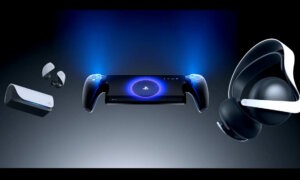[adrotate group = “15”]
It has been twenty-three years in the making, but Final Fantasy VII REMAKE is finally here. With it, players get to relive the enhanced experience of Cloud, Tifa, Aerith and Barret as they challenge Shinra, a corporation draining the world’s core of its mako and slowly killing it. While it’s not a 1:1 recreation of the classic Final Fantasy VII, it is instead a powerful reimagining, one that takes lessons learned from twenty years of game development and integrates it with Cloud’s legendary journey.
If you don’t know about what happens to Cloud and his team during their time in the futuristic city of Midgar, here is a synopsis: Cloud joins eco-terrorist group AVALANCHE to destroy the Mako Reactors Shinra created to drain the planet of its mako. In the process, Cloud meets Aerith, a descent of the first beings on the planet known as the Ancients. Ancients have the ability to listen to the planet and lead people to the “promised land,” a mysterious place apparently filled with mako. Shinra wants to exploit Aerith to get to the promised land while Cloud, Barret and Tifa work to save her from their clutches.
Now, I said FFVII REMAKE is not 1:1, but the major story beats stay the same. The synopsis for FFVII holds for REMAKE. It is, however, how you get from story moment to story moment that elevates the experience of traveling through Midgar. What was a four-hour section of the game is now a 40-hour experience. REMAKE made the time spent in Midgar feel valuable and important to the overarching story to come through an expanded world, character development moments, and upgraded combat mechanics.
Expanded World
As mentioned, the Midgar portion of FFVII was only about four hours of gameplay. This is in part because each of the sections – Sector 5 and 7 slums and Wall Street – were only about two or three individual screens as Cloud and the group traveled through them to get to the next story moment. REMAKE, however, has the players linger in each place a little while.
Wall Street probably received the biggest improvement. Made to be the Las Vegas of Midgar, the graphical improvements really highlight the extravagance of the city. Yet, more so than that, the NPCs littered throughout give off the hedonistic vibe through overhead conversational pieces. The main story also forces you to explore the area deeply, going from a massage parlor, to a battle arena, to Honeybee Inn in order to get to the villainous Don Corneo. Through these additional story elements, players are forced to interact with the world a little bit more than in the original. This isn’t bad at all. In fact, it was enjoyable to come to know the ins and outs of Wall Street in a meaningful way. As with most of the expanded world elements, REMAKE made the world an experience, rather than simply somewhere you had to go to get to the next story elements.
Side quests are a big part of this as each area comes chalk full of them. These side quests range from learning battle mechanics, to exploring the area, to helping NPCs will daily tasks. To be sure, some of the quests are filler, but none of them are mandatory. Finishing the quests leads to Aerith wearing a different dress in Wall Stress, a different hidden scence before heading to Shinra HQ, and an additional materia. However, these don’t really affect the larger story and give you more of a chance to interact with the residents in each area.
Character Development
In my opinion, character development is where the most significant changes occur. Whereas the original had a whole adventure to develop the storylines of each of their characters, REMAKE had to draw out the same affection for the character in Midgar alone. The side quests certainly help flesh out Cloud and the others, this wasn’t enough to make them relatable. Instead, the developers expanded on story moments from the original and made new ones to supplement. Two come to mind: Jessie’s chapter and a roof jumping scene in Sector 5 slums.
Jessie’s chapter is a completely new addition between the two bombing runs. Here, Cloud and the minor characters of Avalanche Wedge, Jessie, and Biggs travel to a storage facility to get explosives for their bomb. Players learn about Jessie’s backstory, see the three minor characters interact, fight alongside Wedge and Biggs, and float down to the slums. These scenes drove home the point that these characters exist in the world outside what we know them for, that they each have their own motivation for trying to fight Shinra. Perhaps, we didn’t need to know about them as they are minor characters, but that we did makes the world seem even more lived in.
The second scene, the roof jumping scene, occurs in the original. Yet, it’s pretty bland and short. We hear a little about Aerith and Cloud, but only snippets that are the small building blocks for the larger relationship that evolves in the later portions of the game. In REMAKE, Aerith and Cloud have the same conversation, but it’s filtered in with scenes of playful banter and childish fun. At the end of the roof jumping, Cloud gracefully jumps down to the ground while Aerith gets flustered and falls. Cloud catches her, prompted her to say, “My Hero.” This scene, new to REMAKE, highlights their relationship. Cloud is the stoic hero and Aerith is his flirty and vibrant foil, opening him up slowly. It’s a perfect moment to encapsulate their relationship and create a really strong foundation for what’s to come.
Combat Mechanics
Another big update to the game was its combat. FFVII was a turn based JRPG, but unlike Pokémon or Persona, your turn comes up based on a time meter that can be sped up or slowed down through spells. Between actions, your characters would simply have to wait until your time meter filled up again before attacking, casting spells, or using items.
In REMAKE, they taken this concept and added a flair of action. Rather than a time meter, each character fills up an ATB meter. In effect, it is the same mechanic: Once the ATB meter fills up, the character can used spells or special attacks. However, between ATB charges, Cloud and the rest of the team can fight using their swords, guns and fists. Attacking enemies fills up the ATB meter faster, incentivizing combat.
This change is a nice refresh on turn based mechanics. Rather than waiting around for their next turn, players can attack, defend, and strategize between all their party in order to take down their enemy.
However, the game wasn’t all polish. There were some graphical and animation issues – resolution on some textures and facial lip-syncing on NPCs were the biggest gripes – but these were relatively small in the grand scheme of things. When the game moves to the PC in a year’s time, the stronger hardware will likely alleviate this issue.
What won’t be changed in the move to PC, however, is the story. While the story was largely an expansion of the original in glorious ways, it wasn’t a 1:1 remake. Instead, the final chapter had Cloud and team literally fighting fate itself. By defeating fate, it is implied that fate, or the original timeline of FFVII, is no more. Anything can happen now. Although I enjoyed that aspect – a 1:1 remake doesn’t make much sense in our time – I know it riled up some fans who wanted the same journey.
I doubt, though, that the development team will deviate tremendously from the old story. Instead, I see this ending as the opportunity to tell fans that there will be changes, that it won’t simply be a shot-for-shot remaster of the originally. Given the care and love that went into REMAKE, I think we can expect the developers will treat the remainder of the game with the same reverence as they did the Midgar portion.
—
There are few games that define the industry; Pong holds the title of one of the earliest video games, Super Mario 64 opened up the world to 3D platformers, Ocarina of Time still has the lasting legacy as the best game ever, and Halo redefined the first-person shooter genre. Final Fantasy VII deserves a spot on that list, popularizing the JRPG genre and leaving gamers with a deeply emotional story.
And although 2020 has been the year of the remake, remasters and enhanced editions – Tokyo Mirage Session, Mega Man Zero/ZX Legacy Collection, Pokémon Mystery Dungeon, Resident Evil 3, and Persona 5 Royal – Final Fantasy VII REMAKE was a master class on how to remake a game. To be clear though, it wasn’t a perfect game. There are some technical flaws, bad texturing, parts of the game that maybe shouldn’t have been remastered, some unenjoyable side quests and more.
But what counts for a remaster, especially one as significant as FFVII REMAKE, is the ability to capture the emotions the original game left with players 23 years ago. With the new graphics, additional character interactions and expanded world, FFVII REMAKE did just that and more. It set up the story of Cloud, Aerith, Tifa and Barret for even more intense emotional rollercoaster than in the original game.
It’s a journey that will take a couple years for sure, but I’m all in for the adventure. Final Fantasy VII REMAKE is an exceptional start.
Follow TechTheLead on Google News to get the news first.


























